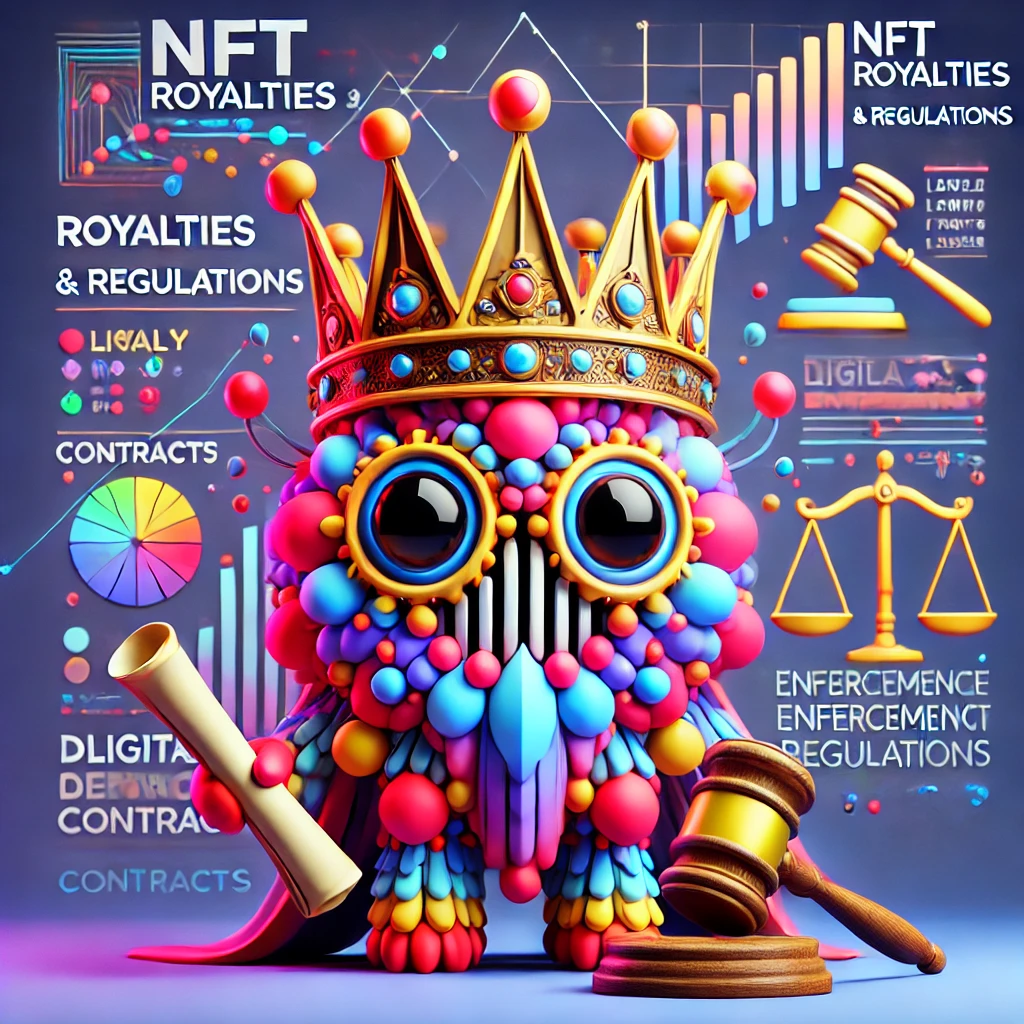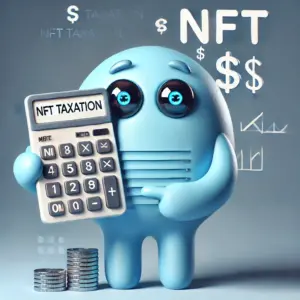The world of non-fungible tokens (NFTs) has exploded in recent years, captivating artists, collectors, and investors alike. At the heart of this burgeoning digital realm lies the concept of royalties – a mechanism designed to empower creators and ensure their ongoing benefit from the secondary market sales of their digital assets. However, the landscape of NFT royalties is complex and often fraught with challenges, especially when navigating the evolving regulatory framework. This comprehensive guide delves into the intricacies of NFT royalties and the crucial legal considerations surrounding their implementation and enforcement.
Understanding NFT Royalties: A Foundation for Creators
Think of NFT royalties as a built-in “tipping jar” for creators. When an NFT is initially minted and sold, the artist can embed a royalty percentage – typically ranging from 5% to 10% – within the smart contract. This percentage represents the artist’s continued share in any subsequent resale of the NFT on marketplaces. Each time the NFT changes hands, the platform automatically deducts the royalty fee and redistributes it to the original artist. This system essentially empowers creators to reap the rewards of their work’s long-term success, even after the initial sale.
Here’s a simple breakdown of how NFT royalties work:
- Artist mints an NFT: When an artist mints an NFT, they specify a royalty percentage in the smart contract attached to the digital asset. This percentage, for example, 5%, will be automatically deducted on every future resale of the NFT.
- Initial sale: The artist receives the full purchase price for the initial sale of the NFT.
- Secondary market sales: Every time the NFT is resold, the platform deducts the predetermined royalty percentage (5% in this example) from the sale price and automatically sends the royalty payment to the original artist.
- Artist earns a share: The artist continues to receive a portion of each resale, fostering ongoing financial benefits from their creative work.
The Benefits of NFT Royalties for Creators
The fundamental purpose of NFT royalties is to empower creators and ensure their ongoing financial participation in the secondary market. Here’s how royalties benefit artists in various ways:
- Sustainable income: Royalties provide a continuous revenue stream for creators, even after the initial sale of their work. This allows artists to monetize their creations for a longer period, potentially generating substantial income throughout the NFT’s lifespan.
- Fair compensation: NFT royalties offer a more equitable system compared to traditional art markets, where artists often receive a disproportionately small share of resale value. This mechanism ensures that artists are fairly compensated for their work, even with subsequent changes in ownership.
- Community engagement: Royalties foster a stronger connection between creators and collectors. The ongoing financial relationship incentivizes collectors to actively participate in the artist’s community, contributing to a thriving ecosystem of support and appreciation.
- Investment in creation: The promise of future royalties incentivizes artists to create more content, knowing that their work will generate ongoing income. This encourages a steady flow of new and innovative digital assets within the NFT ecosystem.
Challenges and Inconsistencies in Implementing NFT Royalties
While the concept of royalties holds immense promise for creators, the practical implementation faces several challenges, leading to inconsistencies and complexities within the NFT ecosystem:
- Lack of uniform enforcement: One significant challenge lies in the lack of a standardized system for royalty enforcement. Different NFT marketplaces adopt differing approaches to royalty collection and distribution, leading to inconsistencies and potential loopholes.
- Market fragmentation: The decentralized nature of the NFT market often results in fragmented ecosystems, making it difficult to track and enforce royalties across various platforms. This makes it challenging for artists to ensure that they receive their rightful share of each resale.
- Limited technical capabilities: Some platforms have technical limitations that hinder the efficient collection and distribution of royalties. This can lead to delays and difficulties in artists receiving their payments.
- Market manipulative practices: There are instances of market manipulation, with individuals attempting to circumvent royalty payments by using “wash trading” or other tactics to artificially inflate the market. Such practices undermine the purpose of royalty systems and harm artists’ financial interests.
Table of Contents:
Navigating the Evolving Regulatory Landscape
The rapid growth of the NFT market has prompted regulatory bodies worldwide to address the legal and financial implications, particularly concerning NFT royalties. The regulatory landscape is constantly evolving, with various jurisdictions grappling with the complex issues surrounding ownership, transparency, and taxation.
The Importance of Legal Clarity and Enforcement
Regulatory clarity and robust enforcement mechanisms are crucial to ensure the stability and legitimacy of the NFT market. Clear guidelines concerning royalty collection and distribution would provide creators with a more predictable and secure environment. It would also reduce the ambiguity and discrepancies that currently plague the industry, fostering greater confidence and trust among participating parties.
Key Regulations and Considerations
Here are some of the key regulations and considerations that are shaping the legal framework surrounding NFT royalties:
- Intellectual property rights: NFT royalties are intrinsically linked to intellectual property rights. Creators are often granted exclusive rights to their digital assets, including the right to collect royalties on future resales. Therefore, regulations must clearly define these rights and ensure their effective protection.
- Contract enforceability: Smart contracts, the underlying mechanism for royalty payments, are subject to legal scrutiny. Regulators are actively exploring the enforceability of smart contracts and establishing legal frameworks for their execution and dispute resolution.
- Tax compliance: The generation of income from NFT royalties raises tax implications. Regulatory frameworks must ensure tax compliance, providing clear guidelines for artists regarding royalty earnings and their corresponding tax liabilities.
- Consumer protection: Regulations are being implemented to protect consumers from scams and deceptive marketing practices associated with NFTs. These regulations aim to ensure transparency in the marketplace and safeguard the rights of NFT buyers.
- Market manipulation: Regulators are actively monitoring and addressing market manipulation practices that can harm artists and the broader NFT ecosystem. This includes tackling activities like wash trading, which artificially inflate prices and undermine the value of royalties.
The Future of NFT Royalties: Towards a Sustainable Ecosystem
While the current NFT royalty landscape faces challenges, the future holds immense potential for creating a more sustainable and equitable ecosystem for creators. Ongoing developments in technology and regulations will shape the trajectory of this evolving field.
Technological advancements
Advancements in blockchain technology are paving the way for more robust and efficient royalty systems. New smart contracts are being developed to enhance the enforceability of royalties, making them less susceptible to manipulation and ensuring timely payments to creators.
- On-chain royalties: The concept of on-chain royalties is gaining traction, where royalty information is directly embedded into the blockchain, making it tamper-proof and readily available to marketplaces and collectors.
- Interoperable royalty systems: Efforts are underway to create interoperable royalty systems that seamlessly integrate across different platforms, ensuring that artists receive their deserved share regardless of where the NFT is sold.
Regulatory progress
Regulatory bodies worldwide are actively working on crafting comprehensive frameworks for the NFT market, particularly focusing on royalty enforcement. Clearer guidelines will not only protect creators but also foster long-term sustainability and confidence within the NFT ecosystem.
- Increased enforcement: Regulatory agencies are intensifying their efforts to crack down on fraudulent activities and market manipulation, safeguarding the interests of creators and investors alike.
- Global coordination: International cooperation among regulatory bodies is crucial to establish a harmonized framework for NFT royalties, ensuring consistency and fairness across global markets.
Collaboration and community engagement
Collaboration among creators, platforms, and regulatory bodies is vital for building a future where NFT royalties are effectively implemented and enforced. This includes initiatives that promote transparency, accessibility, and shared responsibility within the NFT ecosystem.
- Industry standards: Collaborative efforts to establish industry standards for royalty percentages, enforcement mechanisms, and dispute resolution will contribute to a more unified and predictable market.
- Educational resources: Increased access to educational resources will empower creators, collectors, and platform developers to navigate the complexities of NFT royalties and understand their legal and financial implications.
Conclusion: Empowering Creators in the Digital Age
NFT royalties represent a critical step forward in empowering creators in the digital age. They provide a sustainable model for artists to monetize their work and reap the long-term benefits of their creativity. The evolving legal and regulatory landscape presents both challenges and opportunities. By fostering collaboration, leveraging technological advancements, and advocating for clear regulations, we can build a future where NFT royalties are effectively implemented, empowering creators and driving sustainable growth for the NFT ecosystem.
FAQ:
What are NFT royalties?
NFT royalties are a percentage of the sale price of an NFT that is automatically paid to the original creator whenever the NFT is resold on a marketplace. This ensures that artists continue to receive a share of their work’s ongoing success.
How do NFT royalties work?
When an artist mints an NFT, they can specify a royalty percentage (typically 5% to 10%) in the smart contract associated with the digital asset. This percentage is automatically deducted from every resale of the NFT, and the royalty payment is sent to the artist.
What are the benefits of NFT royalties for creators?
NFT royalties provide creators with a continuous revenue stream, ensure fair compensation, foster community engagement, and incentivize the creation of more content.
What are the challenges associated with NFT royalties?
Challenges include a lack of uniform enforcement across marketplaces, market fragmentation, technical limitations, and market manipulation practices.
How are regulations shaping the NFT royalty landscape?
Regulations are addressing issues related to intellectual property rights, smart contract enforceability, tax compliance, consumer protection, and market manipulation.
What are the future prospects for NFT royalties?
Technological advancements like on-chain royalties and interoperable systems are improving the efficiency and security of royalties. Regulatory progress is aimed at achieving greater clarity and enforcement, while collaboration among stakeholders is crucial for building a more sustainable ecosystem.






